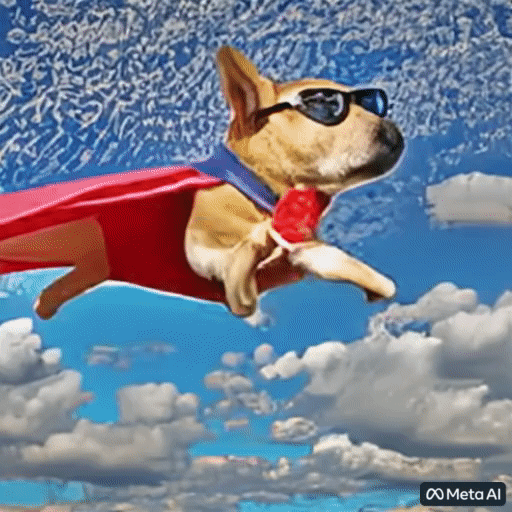Meta’s new AI can turn text prompts into videos
It’s a breakthrough in generative AI that raises some tough ethical questions.

Meta has today unveiled an AI system that generates short videos based on text prompts.
Make-A-Video lets you type in a string of words, like “A dog wearing a superhero outfit with a red cape flying through the sky,” and then generates a five-second clip that, while pretty accurate, has the aesthetics of a trippy old home video.
Although the effect is rather crude, the system offers an early glimpse of what’s coming next for generative artificial intelligence, and it is the next obvious step from the text-to-image AI systems that have caused huge excitement this year.
Meta’s announcement of Make-A-Video, which is not yet being made available to the public, will likely prompt other AI labs to release their own versions. It also raises some big ethical questions.
In the last month alone, AI lab OpenAI has made its latest text-to-image AI system DALL-E available to everyone, and AI startup Stability.AI launched Stable Diffusion, an open-source text-to-image system.
But text-to-video AI comes with some even greater challenges. For one, these models need a vast amount of computing power. They are an even bigger computational lift than large text-to-image AI models, which use millions of images to train, because putting together just one short video requires hundreds of images. That means it’s really only large tech companies that can afford to build these systems for the foreseeable future. They’re also trickier to train, because there aren’t large-scale data sets of high-quality videos paired with text.
To work around this, Meta combined data from three open-source image and video data sets to train its model. Standard text-image data sets of labeled still images helped the AI learn what objects are called and what they look like. And a database of videos helped it learn how those objects are supposed to move in the world. The combination of the two approaches helped Make-A-Video, which is described in a non-peer-reviewed paper published today, generate videos from text at scale.
Tanmay Gupta, a computer vision research scientist at the Allen Institute for Artificial Intelligence, says Meta’s results are promising. The videos it’s shared show that the model can capture 3D shapes as the camera rotates. The model also has some notion of depth and understanding of lighting. Gupta says some details and movements are decently done and convincing.
However, “there’s plenty of room for the research community to improve on, especially if these systems are to be used for video editing and professional content creation,” he adds. In particular, it’s still tough to model complex interactions between objects.
In the video generated by the prompt “An artist’s brush painting on a canvas,” the brush moves over the canvas, but strokes on the canvas aren’t realistic. “I would love to see these models succeed at generating a sequence of interactions, such as ‘The man picks up a book from the shelf, puts on his glasses, and sits down to read it while drinking a cup of coffee,’” Gupta says.
For its part, Meta promises that the technology could “open new opportunities for creators and artists.” But as the technology develops, there are fears it could be harnessed as a powerful tool to create and disseminate misinformation and deepfakes. It might make it even more difficult to differentiate between real and fake content online.
Meta’s model ups the stakes for generative AI both technically and creatively but also “in terms of the unique harms that could be caused through generated video as opposed to still images,” says Henry Ajder, an expert on synthetic media.
“At least today, creating factually inaccurate content that people might believe in requires some effort,” Gupta says. “In the future, it may be possible to create misleading content with a few keystrokes.”
The researchers who built Make-A-Video filtered out offensive images and words, but with data sets that consist of millions and millions of words and images, it is almost impossible to fully remove biased and harmful content.
A spokesperson for Meta says it is not making the model available to the public yet, and that “as part of this research, we will continue to explore ways to further refine and mitigate potential risk.”
Deep Dive
Artificial intelligence
Large language models can do jaw-dropping things. But nobody knows exactly why.
And that's a problem. Figuring it out is one of the biggest scientific puzzles of our time and a crucial step towards controlling more powerful future models.
OpenAI teases an amazing new generative video model called Sora
The firm is sharing Sora with a small group of safety testers but the rest of us will have to wait to learn more.
Google DeepMind’s new generative model makes Super Mario–like games from scratch
Genie learns how to control games by watching hours and hours of video. It could help train next-gen robots too.
Responsible technology use in the AI age
AI presents distinct social and ethical challenges, but its sudden rise presents a singular opportunity for responsible adoption.
Stay connected
Get the latest updates from
MIT Technology Review
Discover special offers, top stories, upcoming events, and more.